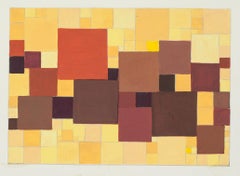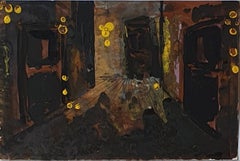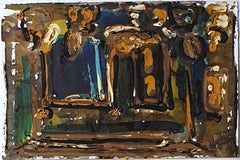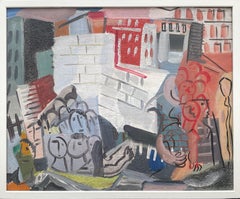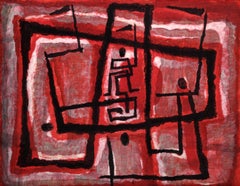Alkis Matheos Abstract Paintings
to
2
3
2
1
3
Overall Height
to
Overall Width
to
2
1
3
45
572
519
320
281
3
3
Artist: Alkis Matheos
Abstract Composition - Original Tempera by A. Matheos
By Alkis Matheos
Located in Roma, IT
Composition is a beautiful original painting in tempera applied on cream-colored paper, realized at the beginning of XX century by the Greek-French artist Mathéos Alkis, Signed on lo...
Category
Mid-20th Century Contemporary Alkis Matheos Abstract Paintings
Materials
Tempera
Abstract Composition - Tempera by A. Matheos
By Alkis Matheos
Located in Roma, IT
Abstract Composition is a beautiful original tempera on paper, realized at the beginning of the XX century by the Greek-French artist Mathéos Alkis. Hand-signed on the lower right ma...
Category
Mid-20th Century Contemporary Alkis Matheos Abstract Paintings
Materials
Tempera
Abstract Composition - Tempera by A. Matheos
By Alkis Matheos
Located in Roma, IT
Abstract Composition is a beautiful original painting in oil and mixed media on paper, realized at the beginning of the XX century by the Greek-French artist Mathéos Alkis. Hand-sign...
Category
Mid-20th Century Abstract Alkis Matheos Abstract Paintings
Materials
Tempera
Related Items
City Scene with Faces casein tempera on canvas by Vaclav Vytlacil
By Vaclav Vytlacil
Located in Hudson, NY
Signed and dated "Vytlacil 32" lower right
Provenance: Estate of the artist #1584; Martin Diamond Fine Art
Exhibitions: 1990 Graham Gallery, NYC (label verso)
About this artist: B...
Category
1930s Abstract Expressionist Alkis Matheos Abstract Paintings
Materials
Tempera, Casein, Canvas
Margaret Balzer, 1946
Located in Washington, DC
Modern painting by Margaret Balzer Cantieni (1914-2002). Tempera on wood board. Signed in lower right corner "Balzer '46". Painting measures 1 1" x 14" with frame 16 1/2" x 19 1/2".
Margaret Balzer studied at the Art Institute of Chicago with Lyonel Feininger, Josef Albers and William Stanley Hayter...
Category
1940s Abstract Alkis Matheos Abstract Paintings
Materials
Board, Egg Tempera
Georgian Contemporary Art by Giorgi Kavelashvili - Expand
Located in Paris, IDF
Acrylic, tempera on wood panel
Giorgi Kavelashvili is a Georgian artist born in 1994 who lives and works in Tbilisi, Georgia. He is graduated from the Tbilisi State Academy of Arts,...
Category
2010s Abstract Alkis Matheos Abstract Paintings
Materials
Canvas, Acrylic, Tempera, Wood Panel
H 43.31 in W 43.31 in D 1.78 in
Simultaneo
Located in London, GB
Through bold colours and striated surfaces, Giulio D'Anna has captured the warmth and vibrancy of the Italian landscape. This collage is an early example of D'Anna's work, a truly cl...
Category
Early 20th Century Alkis Matheos Abstract Paintings
Materials
Tempera, Board
Surface CP/869 Steel
By Guiseppe Capogrossi
Located in Roma, RM
SURFACE CP/869
Steel
1951
Tempera, pencil on twelve paper tiles, on sheet
Tempera, pencil on twelve layers of paper, on sheet
cm 31 x 24 (sheet) 15 x 20 (panel)
EXHIBITONS
F.R. Mor...
Category
1950s Abstract Alkis Matheos Abstract Paintings
Materials
Paper, Mixed Media, Tempera
The Three Emperors, Futuristic painting triptych as a Byōbu-ē folding screen
By Konstantinos Papamichalopoulos
Located in Dallas, TX
The Three Emperors is a triptych, which Papamichalopoulos has created a Byōbu-ē folding screen. Each panel measures 150x40 cm / 59 x 16 inches.
The piece is created using ink, egg-...
Category
2010s Contemporary Alkis Matheos Abstract Paintings
Materials
Gold Leaf
H 59.06 in W 47.25 in D 1.19 in
White Dawn
By John Little
Located in Austin, TX
Egg emulsion on fiberglass. Signed and dated upper left and verso; titled verso.
49 x 48 in.
49.75 x 49 in. (framed)
Custom framed in hickory.
Provenance
Albright-Knox Art Gallery, Buffalo, NY
Born in Alabama, John Little attended the Buffalo (NY) Fine Arts Academy as a teenager, until 1927. Soon after, he moved to New York where he began operatic vocal training and opened what would become a very successful textile business designing fabric and wallpaper.
In 1933, he enrolled at the Art Students League under the tutelage of George Grosz. Little’s early work consisted predominantly of landscapes, until 1937, when he began studying under Hans Hofmann and his work naturally shifted toward abstraction. During his time with Hofmann, he with artists such as Lee Krasner, George McNeil, Gerome Kamrowski, Giorgio Cavallon...
Category
1960s Abstract Expressionist Alkis Matheos Abstract Paintings
Materials
Fiberglass, Egg Tempera
Ceremonial Dancers oil and tempera painting by Julio De Diego
By Julio de Diego
Located in Hudson, NY
Artwork measures 48" x 30" and framed 56 ¼" x 38 ¼" x 3"
Provenance:
John Heller Gallery, NYC, circa 1975 (label verso)
The artist's daughter
Corbino Galleries, Sarasota, FL (1990)...
Category
1940s Modern Alkis Matheos Abstract Paintings
Materials
Masonite, Oil, Tempera
St. Atomic oil and tempera painting by Julio de Diego
By Julio de Diego
Located in Hudson, NY
Julio De Diego’s Atomic Series paintings made an extraordinary statement regarding the shock and fear that accompanied the dawn of the nuclear age. In the artist’s own words, “Scientists were working secretly to develop formidable powers taken from the mysterious depths of the earth - with the power to make the earth useless! Then, the EXPLOSION! . . . we entered the Atomic Age, and from there the neo-Atomic war begins. Explosions fell everywhere and man kept on fighting, discovering he could fight without flesh.”
To execute these works, De Diego developed a technique of using tempera underpainting before applying layer upon layer of pigmented oil glazes. The result is paintings with surfaces which were described as “bonelike” in quality. The forms seem to float freely, creating a three-dimensional visual effect. In the 1954 book The Modern Renaissance in American Art, author Ralph Pearson summarizes the series as “a fantastic interpretation of a weighty theme. Perhaps it is well to let fantasy and irony appear to lighten the devastating impact. By inverse action, they may in fact increase its weight.”
Exhibited
1950 University of Illinois at Urbana "Contemporary American Painting"
1964 Marion Koogler McNay Art Institute, San Antonio, Texas
This work retains its original frame which measures 54" x 36" x 2".
About this artist: Julio De Diego crafted a formidable persona within the artistic developments and political struggles of his time. The artist characterized his own work as “lyrical,” explaining, “through the years, the surrealists, the social-conscious painters and the others tried to adopt me, but I went my own way, good, bad or indifferent.” [1] His independence manifested early in life when de Diego left his parent’s home in Madrid, Spain, in adolescence following his father’s attempts to curtail his artistic aspirations. At the age of fifteen he held his first exhibition, set up within a gambling casino. He managed to acquire an apprenticeship in a studio producing scenery for Madrid’s operas, but moved from behind the curtains to the stage, trying his hand at acting and performing as an extra in the Ballet Russes’ Petrouchka with Nijinsky. He spent several years in the Spanish army, including a six-month stretch in the Rif War of 1920 in Northern Africa. His artistic career pushed ahead as he set off for Paris and became familiar with modernism’s forays into abstraction, surrealism, and cubism.
The artist arrived in the U.S. in 1924 and settled in Chicago two years later. He established himself with a commission for the decoration of two chapels in St. Gregory’s Church. He also worked in fashion illustration, designed magazine covers and developed a popular laundry bag for the Hotel Sherman. De Diego began exhibiting through the Art Institute of Chicago in 1929, and participated in the annual Chicago Artists Exhibitions, Annual American Exhibitions, and International Water Color Exhibitions. He held a solo exhibition at the Art Institute of Chicago in the summer of 1935. Though the artist’s career was advancing, his family life had deteriorated. In 1932 his first marriage dissolved, and the couple’s young daughter Kiriki was sent to live with friend Paul Hoffman.
De Diego continued to develop his artistic vocabulary with a growing interest in Mexican art. He traveled throughout the country acquainting himself with the works of muralists such as Carlos Merida, and also began a collection of small native artifacts...
Category
1940s American Modern Alkis Matheos Abstract Paintings
Materials
Masonite, Oil, Tempera
Le Jeu des Perles de Verre
By Gonçalo Ivo
Located in Miami, FL
Gonçalo Ivo was born in Rio de Janeiro, Brazil in 1958. He is the son of Brazilian writer and poet, Lêdo Ivo. His work has been the focus of over 40 solo exhibitions and can be found...
Category
21st Century and Contemporary Abstract Geometric Alkis Matheos Abstract Paintings
Materials
Canvas, Linen, Oil, Tempera
The Magician oil and tempera painting by Julio de Diego
By Julio de Diego
Located in Hudson, NY
Julio De Diego’s Atomic Series paintings made an extraordinary statement regarding the shock and fear that accompanied the dawn of the nuclear age. In the artist’s own words, “Scientists were working secretly to develop formidable powers taken from the mysterious depths of the earth - with the power to make the earth useless! Then, the EXPLOSION! . . . we entered the Atomic Age, and from there the neo-Atomic war begins. Explosions fell everywhere and man kept on fighting, discovering he could fight without flesh.”
To execute these works, De Diego developed a technique of using tempera underpainting before applying layer upon layer of pigmented oil glazes. The result is paintings with surfaces which were described as “bonelike” in quality. The forms seem to float freely, creating a three-dimensional visual effect. In the 1954 book The Modern Renaissance in American Art, author Ralph Pearson summarizes the series as “a fantastic interpretation of a weighty theme. Perhaps it is well to let fantasy and irony appear to lighten the devastating impact. By inverse action, they may in fact increase its weight.”
Exhibited
1964 Marion Koogler McNay Art Institute, San Antonio, Texas
This work retains its original frame which measures 54" x 42" x 2"
About this artist: Julio De Diego crafted a formidable persona within the artistic developments and political struggles of his time. The artist characterized his own work as “lyrical,” explaining, “through the years, the surrealists, the social-conscious painters and the others tried to adopt me, but I went my own way, good, bad or indifferent.” [1] His independence manifested early in life when de Diego left his parent’s home in Madrid, Spain, in adolescence following his father’s attempts to curtail his artistic aspirations. At the age of fifteen he held his first exhibition, set up within a gambling casino. He managed to acquire an apprenticeship in a studio producing scenery for Madrid’s operas, but moved from behind the curtains to the stage, trying his hand at acting and performing as an extra in the Ballet Russes’ Petrouchka with Nijinsky. He spent several years in the Spanish army, including a six-month stretch in the Rif War of 1920 in Northern Africa. His artistic career pushed ahead as he set off for Paris and became familiar with modernism’s forays into abstraction, surrealism, and cubism.
The artist arrived in the U.S. in 1924 and settled in Chicago two years later. He established himself with a commission for the decoration of two chapels in St. Gregory’s Church. He also worked in fashion illustration, designed magazine covers and developed a popular laundry bag for the Hotel Sherman. De Diego began exhibiting through the Art Institute of Chicago in 1929, and participated in the annual Chicago Artists Exhibitions, Annual American Exhibitions, and International Water Color Exhibitions. He held a solo exhibition at the Art Institute of Chicago in the summer of 1935. Though the artist’s career was advancing, his family life had deteriorated. In 1932 his first marriage dissolved, and the couple’s young daughter Kiriki was sent to live with friend Paul Hoffman.
De Diego continued to develop his artistic vocabulary with a growing interest in Mexican art. He traveled throughout the country acquainting himself with the works of muralists such as Carlos Merida, and also began a collection of small native artifacts...
Category
1940s American Modern Alkis Matheos Abstract Paintings
Materials
Masonite, Oil, Tempera
Stuttgart No. 16, 1958
By Harry Bertschmann
Located in Quogue, NY
Casein, dry pigments on paper board
Category
1950s Abstract Alkis Matheos Abstract Paintings
Materials
Paper, Casein, Pigment
Alkis Matheos abstract paintings for sale on 1stDibs.
Find a wide variety of authentic Alkis Matheos abstract paintings available for sale on 1stDibs. If you’re browsing the collection of abstract paintings to introduce a pop of color in a neutral corner of your living room or bedroom, you can find work that includes elements of orange and other colors. You can also browse by medium to find art by Alkis Matheos in paint, tempera and more. Much of the original work by this artist or collective was created during the 20th century and is mostly associated with the contemporary style. Not every interior allows for large Alkis Matheos abstract paintings, so small editions measuring 7 inches across are available. Customers who are interested in this artist might also find the work of Lorenzo Chavez, Marisa Busanel, and Ralph Anderson. Alkis Matheos abstract paintings prices can differ depending upon medium, time period and other attributes. On 1stDibs, the price for these items starts at $110 and tops out at $324, while the average work can sell for $264.
